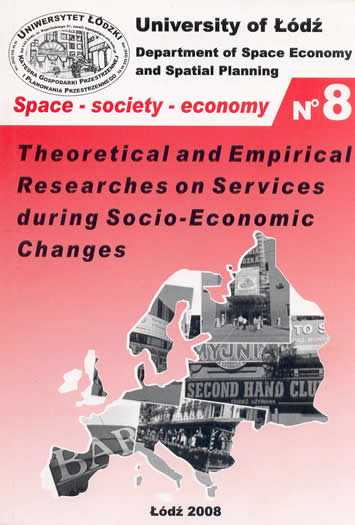Usługi komercyjne w Poznaniu – struktura przestrzenno-funkcjonalna
DOI:
https://doi.org/10.18778/1733-310.08.08Abstrakt
The paper presents the location and sectoral structure of commercial services in Poznań as established by the author for 89 city-planning units. Its basic aim is to analyse the spatial-functional structure of the network of service establishments in Poznań and to assess its level of satisfaction of consumer needs. The chief method of data acquisition was making an inventory of service establishments. It embraced 7,316 entities representing 23 sectors of service establishments and equipment, in accordance with the Polish Classification of Economic Activities. Poznań experiences a never-ending succession of service establishments and changes in their location. One can observe here the processes of both, concentration and deconcentration of services. The diffusion of services to areas outside the traditional downtown location is the result of the emigration of the population and economic entities to city peripheries and an increase in the accessibility of services brought about by advances in motorisation and telecommunication. Service providers (e.g. groceries, hairdressers, dry-cleaners, etc.) appear on new housing estates. One can also observe the ‘flight’ to the peripheries or areas outside city limits of consumer services seeking economies of scale. Service establishments accompany hypermarkets. Also constructed are recreational, entertainment and cultural complexes (e.g. multiplex cinemas) designed as an alternative to the service offer and public spaces of the Poznań centre. In turn, for advisory, legal, banking, tourist and other services of this type, important considerations are the location in the city centre, nearness of co-operating partners, suitable architectural and social milieu, etc. This boosts the rent for premises, which eliminates providers of the most popular services, small and economically weak, from the market. In the downtown area small establishments often lose the fight for space to big firms and chains, increasingly associated with foreign and international capital. In the distribution of services in Poznań, readily visible are differences in the location orientation of the individual sectors. They can be divided into services with a distinct consumer orientation, whose distribution is closely connected with that of the population, and freely oriented (non-consumer) sectors.
Pobrania
Bibliografia
Klima E., Bartkowski J., Usługi gastronomiczne, [w:] Usługi rynkowe w Łodzi w dobie transformacji, (red.) J. Dzieciuchowicz, Wydawnictwo Uniwersytetu Łódzkiego, Łódź 2005.
Google Scholar
Kaczmarek T., Kaczmarek U., Bednarek R. Struktura przestrzenno-funkcjonalna usług komercyjnych w Poznaniu i jej ocena z punktu widzenia zaspokojenia potrzeb mieszkańców, Miejska Pracownia Urbanistyczna w Poznaniu, Dedal Invest-Eko, Poznań 2004.
Google Scholar
Rogoziński K., Usługi rynkowe, Akademia Ekonomiczna w Poznaniu, Poznań 2000.
Google Scholar
Wilk W., Czynniki lokalizacji i rozmieszczenie wybranych usług w Warszawie, Uniwersytet Warszawski, Warszawa 2001.
Google Scholar
Pobrania
Opublikowane
Jak cytować
Numer
Dział
Licencja

Praca jest udostępniana na licencji Creative Commons Attribution-NonCommercial-NoDerivatives 3.0 Unported License.









